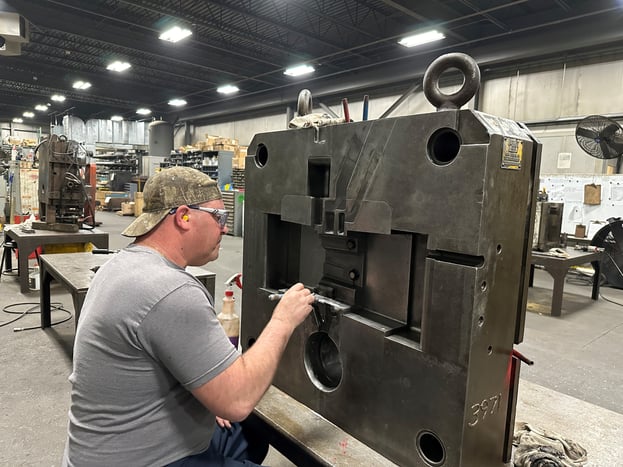Before we publish “The next 5 qualities you should require of your die caster,” let’s talk about tooling. A die caster that possesses our “top qualities” will maximize the life of die cast tooling. This is important as it is a significant investment for the customer. A purchaser of die castings must plan for the inevitable cost and time required to replace tooling. Here are some common questions we receive from our customers about die cast tooling.
How long will my die last?
We tell our customers to plan on 100,000 shots from their cavities. A two-cavity die will yield at least 190,000 good parts when scrap is accounted for. At GDC we typically exceed this number, but you should plan to have resources available to build replacements at this time. Expect the best, but plan for the worst.
The quality requirements and geometry of the casting will influence the life of the cavity. A cavity for a part with cosmetic requirements may need to be replaced at 40,000 shots, whereas an axle housing hidden under a lawn tractor may live for 250,000 shots. A casting with constant wall thickness <.150” will have a longer life than one with walls over .5” thick. At GDC, we can provide a very good estimate for the life if your tooling.
The holder block should be reconditioned with each new set of cavities. This involves taking a thin cut off the face to ensure proper shut off, rebuilding hydraulic cylinders, replacing slide wear components, etc. You can expect your holder to survive three sets of cavities before it needs to be replaced.
Your trim die should be refurbished every 2-3 sets of cavities.

Adam Miller, a GDC Tool Room Tech, thoroughly cleaning a die after production to evaluate its condition.
When do I need to start new cavities?
The monthly usage of the casting will impact the timing. A set of new cavities may take 8-12 weeks to build and fit into the holder. The tool shop will require the holder block for at least 2 weeks during this process. This means that no production will occur. The die will then need to be sampled, dimensional checks & capability studies completed and approved by the customer. This can easily take another 4-8 weeks for a total of 20 weeks. For this reason, it is critical that a plan is in place for new tooling to be kicked off before the current cavity and inventory is exhausted.
Are there options for replacing cavities?
It is sometimes possible to “sink” a cavity. This practice involves cutting or burning the cavity in the same piece of steel, only deeper. The back of the cavity can be welded and cut flat to make up the difference. This is typically done on parts with simple geometry without slides. The life of the re-sink will not match the original cavity, but it may prove cost-effective.
It may be difficult to justify new tooling for a part with low volume. We have negotiated pricing with the customer to account for added scrap and downtime associated with the worn tooling. We can make weld repairs to prolong the life of the die.
What happens if you keep running the die?
At some point, it will become unsafe to continue production. A die must have adequate steel shut off to hold the molten metal as it is injected, and pressure is applied. Once the die steel is compromised, then it must be retired.
Catastrophic failure will eventually occur. Typically, the die cracks from fatigue. The crack will propagate until the entire cavity fractures into pieces.
How do I know when my tooling needs to be replaced?
At General Die Casters our Plant Wide Process Monitoring system, the Shotscope, automatically tells our ERP system when a shot is made on your die. Our Engineering department sends a report to each of our customers on a regular basis with the current number of shots and the anticipated life remaining. We regularly remind our customers to stay ahead of tooling replacement and will provide quotes when requested.
How do I pay for replacement tooling?
There are two ways.
Pay as you go.
We will provide a quote for replacement tooling when the die is approaching 100,000 shots. You issue a PO and we will work with a tool shop to have them constructed.
Perpetual Tooling.
Obtaining approvals for capital expenditures is never easy. Some customers prefer to add additional money to the casting price for replacement cavities. The perpetual tooling price is basically the projected cost of new cavities divided by the expected number of shots. The die caster is then responsible for replacing cavities when needed to avoid production interruptions.
We have used both methods at GDC and will work with the customer on the right process for you.
Do you have additional questions or need more detail? Contact General Die Casters today!

